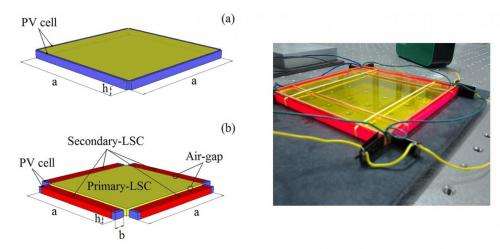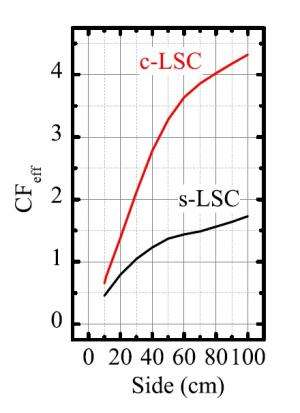April 30, 2014 feature
Cascade solar concentrator greatly reduces solar cell footprint

(Phys.org) —Solar cells are often made of expensive materials, which is why much research is focused on finding cheaper materials in order to reduce the overall cost of solar energy. Another way around this problem is to use solar concentrators—cheaper light-absorbing materials that cover a large area, which absorb, redirect and focus light onto a smaller area containing the actual solar cells. While the solar cells are still expensive, fewer of them are needed to generate a given amount of electricity because they receive more sunlight.
In a new study published in Applied Physics Letters, Sthy Flores Daorta, et al., at the University of Pavia in Pavia, Italy, and the Eni Donegani Institute's Research Center for Non-Conventional Energies in Novara, Italy, have proposed and fabricated a new design for luminescent solar concentrators (LSCs).
The new LSCs consist of a cascade of two LSCs with solar cells attached only at the corners. This design offers the unique advantage that the area covered by solar cells is independent of the area over which sunlight is collected. Initial experiments showed that these cascade-LSCs (c-LSCs) can concentrate 55% more light than corresponding traditional LSCs.
"This concept—that the area covered by solar cells is independent of the area over which sunlight is collected—is new in the field of luminescent solar concentrators and it opens perspectives, e.g., for developing solar cells (even if more expensive) that are specifically tailored for efficient photovoltaic conversion at the collection wavelength," coauthor Lucio Claudio Andreani at the University of Pavia told Phys.org.

Since the first LSCs for solar applications were introduced in the 1970s, their design has not changed substantially. Traditional LSCs consist of one dielectric slab doped with fluorescent dyes. The dyes absorb sunlight and then re-emit it at lower energies, after which it is absorbed by the solar cells and converted into photocurrent. The biggest factor affecting LSC performance is how well the dyes absorb and re-emit light at different frequencies, which has led to a lot of research on different types of dyes and strategies to improve their light absorption.
In the new design, the researchers used dyes that are typically implemented in LSCs, but changed the overall structure of the LSC. With two cascading LSCs, the first LSC contains dyes that absorb in the desired spectrum of incident sunlight, while the second LSC contains dyes that absorb in the spectrum of the light emitted by the first LSC. In a sense, the light is concentrated twice before arriving at the solar cells.
The researchers' calculations show that the c-LSC's concentration factor increases with the square of the side length of the concentrator. For a side length of 80 cm, a c-LSC can concentrate sunlight by a factor of more than 4 compared to the sunlight concentration that would be obtained by direct illumination of the solar cells. For comparison, a traditional LSC with a side length of 80 cm has a theoretical concentration factor of about 1.5.
In experiments, the researchers fabricated smaller prototypes, and so the concentration factors were smaller but still in agreement with the theoretical predictions. The experiments showed that an 11 x 11 cm c-LSC has a concentration factor of 0.67, which is about 55% higher than the 0.43 concentration factor for a corresponding traditional LSC. Although both concentrations are actually lower than that which would be achieved by direct illumination of the solar cells (which have a concentration factor of 1), the main limitation is the dimensions used in the experiments, reflecting the area of the researchers' solar simulator.
In addition to increasing the dimensions, another way to improve the c-LSC performance is to optimize the dyes. The researchers hope to work on both of these improvements in the future.
"We plan to optimize the geometry of the c-LSC and to develop dyes that have a better overlap between emission spectrum of the primary and absorption spectrum of the secondary," Andreani said.
More information: Sthy Flores Daorta, et al. "Cascade luminescent solar concentrators." Applied Physics Letters 104, 153901 (2014). DOI: 10.1063/1.4871481
Journal information: Applied Physics Letters
© 2014 Phys.org





















